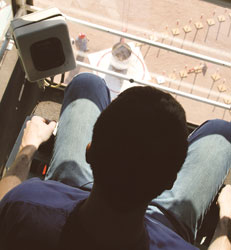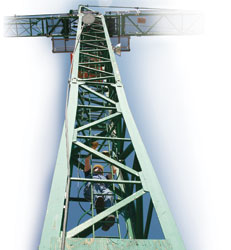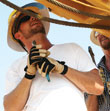The air conditioner was buzzing and blowing to keep up with the desert sun, but the small window unit had already lost its cool. My hands—shaky and slippery with sweat—were having trouble keeping a grip on the controls. Nestled high in the cab of a 100-ft-tall crane, I was about to take my final exam on a blazing Friday afternoon in early October. I had just spent a week at the Tower Crane School of Phoenix, a one-acre facility in Apache Junction, Ariz., learning the ropes from Ronald M. Gray, the school’s owner. If I passed the test, I would be in most parts of the U.S. perfectly qualified to run a crane on a real jobsite. Despite this reality, many experts believe that a licensed operator is incomplete without experience.
 |
 Van Hampton (top and above) gets a first-hand look at cranesafety training at school in Arizona.
|
A lifting specialist and former bodybuilder, Gray, 56, has trained hundreds of crane operators. The son of a Navy SEAL, Gray started out aboard the Sarita, an oil tanker built in Sweden in 1965, converted into a heavy-lift vessel in 1976. He joined the crew as a rigger, becoming foreman. Running a 2,000-ton Clyde crane, Gray was the center of the action. Thirty years later, he is in the middle of an age-old construction debate: What is the most effective way to measure skill?
Crane operators sit all day long in a “hot” seat, expected to pick up objects of all shapes and sizes, each time safely and effortlessly. Not every lift goes smoothly. “I nearly got myself in a couple of jams,” Gray admits. His heaviest, single lift was 1,600 tons—the equivalent of about 1,200 Honda Civics—and sometimes, the little lifts can be just as tough. In 1986, after the Challenger space shuttle exploded after takeoff, Gray was hired to pluck from the depths of the ocean the infamous o-ring, about the size of a golf ball.
Gray impresses upon his students that safe lifting is all about load control. Having never sat in a tower crane, I soon discovered how operators must keep the hook “quiet,” or still, as the crane constantly moves to keep up with production. The trick, I learned, is to anticipate movements before they start. “You learn all that out on the ocean because you are rocking and rolling,” Gray says. “Dishes fall down in the galley, but you never stop catching your load.”
The construction industry has been rocking and rolling in the wake of several fatal crane accidents this year. Though collapsed tower cranes have landed regularly on the evening news, they represent only 5% of all such accidents in the U.S.—many more are mobile cranes, according to statistics. Yet tower cranes impact the public the most because they usually serve a wider footprint. As such, these operators can earn up to $150,000 per year, but they can also cause millions in damage. This is not a job to take lightly.
Measuring the skill of crane operators is not a new idea, yet operators are fairly new to standardized testing. In the old days, contractors and professional trainers would make up their own tests. But new laws now are requiring tests to meet certain guidelines. Written and hands-on tests for mobile crane operators held to the same psychometrics standards as medical exams have been available for only 12 years, while accredited tower-crane tests have been around for only four years. Construction workers now are catching up with other fields that certify, and the growing pains are apparent.
 Guy Lawernce/ENR
| “You don't want to walk away with 90 degrees of knowledge, you want 360. ” — GRAHAM BRENT, EXEC. DIRECTOR, NCCCO, FAIRFAX, VA.
|
In the U.S., only one-third of all states require this kind of testing for crane operators. Only a handful of cities do as well. But a pending U.S. Occupational Safety and Health Administration regulation would require operators of all cranes in the U.S. with at least one-ton capacity to be certified under a nationally-accredited, standardized test. The future of crane safety is in the hands of the schools.
Meet the Class
Because I had never operated a crane before, I had to get some hands-on experience before I could expect to pass. A week’s worth of training in the desert is not exactly a vacation in paradise. Afternoon temperatures here regularly climb to 100° F, and dusty breezes cause loads to sway off course. An experienced operator’s second-nature ability to “catch” the load before it veers wildly out of control, I soon learned, would be the key to passing the test. Neither gravity nor wind is a friend to crane operators.
 Guy Lawernce/ENR
| “Just because you have years of experience doesn’t mean you have everything you need.” — RONALD M. GRAY, OWNER, TOWER CRANE SCHOOL OF PHOENIX, APACHE JUNCTION, ARIZ.
|
Gray gave me no breaks. I was on equal footing with three other students: Sitting next to me in the classroom on day one was 26-year-old John Paul Childers, who quit his job at a factory in Murfreesboro, Tenn., and made the two-day drive to take Gray’s three-week mobile and tower class, costing $7,500. Becoming a crane operator is a “lifelong ambition,” Childers says. “I always wanted to operate a crane, so here I am.”
Also present was Keith Crawford, 53, who started out operating a 15-ton, Galion rough-terrain crane in 1975 and now makes his living as a tower crane operator and foreman. Crawford was well qualified when he took our class, but not so in 1975. A young Crawford had stepped up to the hiring gate of the Comanche Peak nuclear plant in Glen Rose, Texas, then under construction. He fibbed and said that he had two years of experience. A Brown & Root supervisor tested him at the controls—the young novice took note of the diagrams on the levers and winged it—and he scored the job.
|
Would that “test” pass today? “No way,” Crawford says. What attracts many young workers to cranes is the money and the glory, and tower operators are particularly well paid. “You can make five, six, seven dollars an hour more than conventional operators,” says Crawford. An employee of Greeley, Colo.-based Hensel Phelps Construction Co., Crawford came here so he could work on a project at the University of Texas, which requires certification.
She may have driven just about every car under the sun, but 43-year-old Beverly Stutes found herself going through “the midlife crisis thing.” Having recently purchased the obligatory Harley motorcycle, she was growing weary of trucking cars between dealerships in Phoenix. So Stutes joined Childers in the three-week intensive class. She expected the training to try her patience, which it did, but she didn’t expect job offers to come a week before graduation. “I went from bored to overwhelmed,” she says.
Our first day was spent inside an air-conditioned trailer reviewing the rules of crane operations. We skimmed through the past two editions of American Society of Mechanical Engineers’ standards ASME B30.3-1996 and ASME B30.3-2004 (construction tower cranes), ASME B30.23-1998 (personnel lifting), various federal regulations as well as the Tower Crane Reference Manual, published by the Fairfax, Va.-based National Commission for the Certification of Crane Operators.
 Guy Lawernce/ENR
| “I‘ve always wanted to operate a crane, so here I am.” — JOHN CHILDERS, CRANE OPERATOR CANDIDATE, MURFREESBORO, TENN.
|
At the end of the day, we took a multiple-choice practice test that Gray developed, though he had no knowledge of the actual questions because the tests are administered by an independent proctor, International Assessment Institute. This is done to prevent corruption, says Graham Brent, NCCCO’s executive director.
When our class took the practice test, all of us barely hit or just came up short of the minimum 70% required to pass. More cramming helped. At the end of the week, Crawford and I would have an hour to complete the real 55-question exam and handily did so with time to spare. Stutes and Childers successfully made it through five and a half more hours of testing for their mobile-crane endorsements, including a vigorous round of load-chart questions exclusive to mobile cranes, with no calculators allowed.
Every five years, operators must take this test again to keep their cards. But crane standards are regularly revised and often contradict each other. For example, the allowable deviation for a tower-crane hook’s opening is 10%. For mobile cranes, 15%. Likewise, the minimum number of times wire rope must be wrapped around a hoist drum is two in the ASME standard but three in the Tower Crane Reference Manual. You need to know the variants to pass the test.
Not all candidates have the same attention span, and Gray recognizes this. In the classroom, he jumped from subject to subject quickly to make sure we were exposed to a broad swath of knowledge. Assessing general knowledge is the intent of the exam, Brent says: “You obviously don’t want someone walking away from the test with only 90 degrees of knowledge. You want 360 degrees.”
 Guy Lawernce/ENR
| “I would rather somebody put the fear of God into me than say everything is all right.” — BEVERLY STUTES, CRANE OPERATOR CANDIDATE, PHOENIX, ARIZ.
|
Today is an important time for crane workers. Since crane-operator certification arrived in 1996, about 65,000 operators from 50 states have been tested, says NCCCO (commonly called CCO). OSHA estimates at least 60,000 more operators may need to pass similar exams to comply with the pending rules, in a period of only four years. NCCCO also is developing courses for riggers, signalers and inspectors.
In the wake of this year’s accident streak, the public has learned that only a handful of states and cities require crane operators to pass some sort of test before they can sit behind the controls. Political...
 Related Links:
Related Links: 

Post a comment to this article
Report Abusive Comment